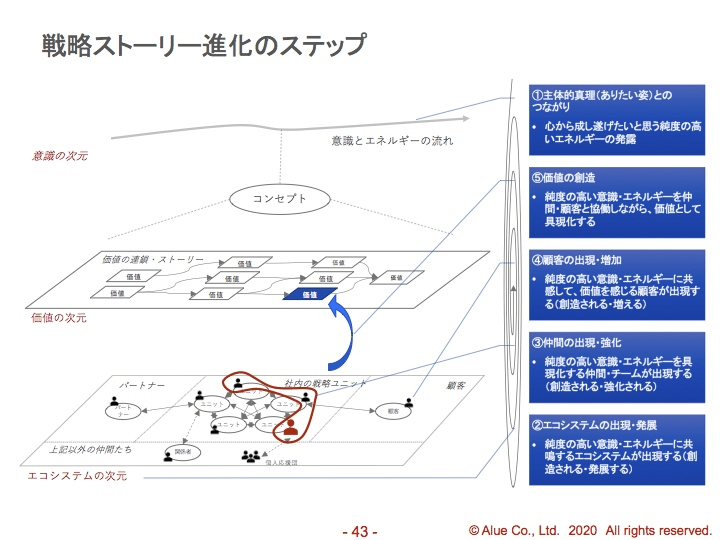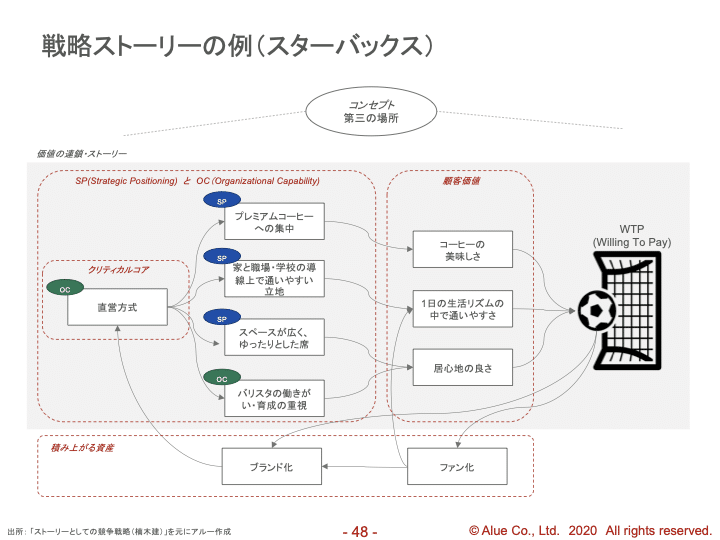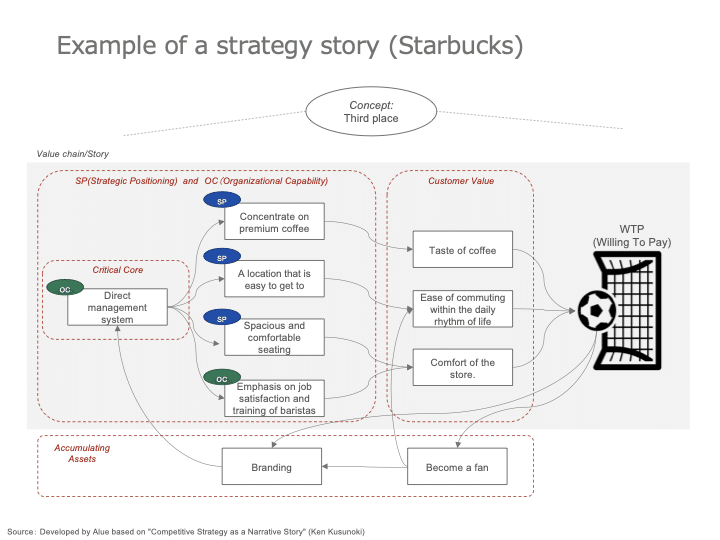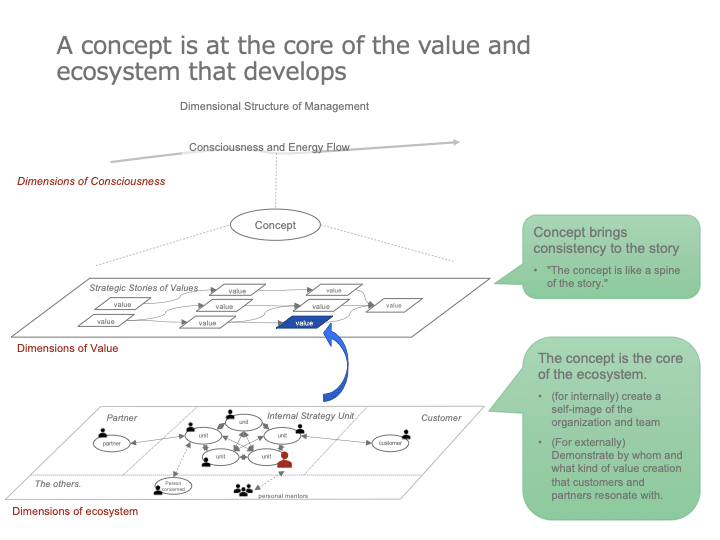
戦略ストーリーに一貫性を持たせるには?
前回の記事では、戦略ストーリーを生み出すために、エコシステム的なつながりに目を向けて仲間と顧客を集めていくということをお話ししました。また、仲間や顧客になるような共感ベースのつながりの根底には、みなさんが発する主体的真理への強い共鳴があるということをお伝えしました。
今回は、仲間や顧客とのつながりをもとに、価値を創造するプロセスについてお話しします。まずは、戦略ストーリーの5つの進化ステップをおさらいしましょう。

前回までは②~④、つまりエコシステムから仲間と顧客が集まるプロセスを扱ってきました。今回からは、⑤価値の創造プロセスの詳細に入っていきます。
価値創造の機序を詳しく説明する前に、価値創造の大前提となるコンセプトについて考えたいと思います。
価値創造というのは、上図において、価値の次元において、価値の連鎖・ストーリーに価値要素が加わり、全体としての顧客価値が高まることを指します。価値の次元にある全ての価値は、コンセプトとつながっています。
ですから、価値創造を考えるためには、まずコンセプトとは何かについて明らかにする必要があります。
価値はコンセプトから生まれる
戦略ストーリーにおける価値とは、ストーリーをつなぐ一つひとつの要素のことです。次のスターバックスの例で言えば、四角の枠で囲まれているもの一つひとつが価値となります。

エコシステムにおいて純度高くエネルギーを共有する仲間・顧客との協業の中で、価値は具現化されます。その起点は「コンセプトが意識されること」です。
コンセプトとは、戦略ストーリーに一貫性を持たせるような、背骨となる概念です。スターバックスで言えば「第三の場所」の概念を指します。上図の一つひとつの価値要素が、第三の場所という自宅でも職場でもない場所を提供するというコンセプトに見事に繋がっていることを実感いただけるのではないでしょうか。
当社の例でいえば、「育成成果にこだわる」というコンセプトを持っています。新しい価値要素として商品やサービスを考えるときには、必ず「育成成果にこだわる」というコンセプトとどのようにつながるのかを常に考えています。
コンセプト=「アイデンティティ」+「コアバリュー」
それでは、コンセプトとは何かについて考えていきましょう。
コンセプトの定義(落合の考え)
自分たちのアイデンティティと顧客価値の本質を端的に表現したもの
平たく言えば、「自分たちは何者で、本当のところどんな価値を提供しているのか?」という問いに対する答えがコンセプトです。
コンセプトの構成要素の観点からも説明します。コンセプトは「アイデンティティ」と「コアバリュー」で構成されます。アイデンティティとは、自分(たち)は何者であるか。コアバリューとは、顧客に何を提供するか。その両方の要素を含むのがコンセプトです。

コンセプト自体、必ずしも言語化されているとは限りません。また、アイデンティティとコアバリューという形で分解して言語化する必要もありません。
ただし、仲間と顧客の意識レベルでコンセプトが共有されていることは必須です。「自分たちは何者か?」「顧客に何を提供するか?」について、イメージを共有している状態が重要です。
自社あるいは自チームにおいて、このようなイメージが共有できていない場合、目の前でやっている業務は問題なく遂行できても、新しい価値創出ができなかったり、ヴィジョン実現への変革が進まなかったりします。
このような場合には、自分たちは何者か、顧客にどんな価値を提供するのか、について対話をすることで、コンセプトを明確化・言語化しながら、すり合わせていくことはとても効果的なアプローチであると思います。
なぜ、コアバリューだけではいけないのか?
「コンセプトは、顧客への提供価値だけを考えればいいのではないか?」 「なぜ、アイデンティティが必要なのか?」このような疑問を持たれた方もいらっしゃるかもしれません。

確かに、一般的には、コンセプトとは顧客への提供価値のことである、と定義されていることが多いと思います。しかし、私は、顧客への提供価値だけではなく、アイデンティティを一緒に考えることをお勧めしたいと思います。
アイデンティティが変わると、意識が変わり、行動が変わるからです。
例えば、私は家庭では3児の父というアイデンティティを持っていますが、会社では社長というアイデンティティを持っています。家にいるときの自分と、会社にいるときの自分は、同じ自分ではありますが、その意識の持ち方や行動は異なるところがあります。
当社の営業チームの例で言えば、「育成成果を創出するための、お客さまの課題解決のパートナー」というアイデンティティを言語化しています。このアイデンティティは、最近チーム内で対話をしながら紡いだものです。それ以前は、アイデンティティを言語化していたわけではありませんでしたが「研修サービス提供者(研修ベンダー)」というイメージがありました。
「お客さまの課題解決のパートナー」というアイデンティティと、「研修ベンダー」というアイデンティティでは、意識の持ち方や行動が全く違ってきます。
例えば、お客様から「XXというテーマの研修をやりたい」という話を聞いたときに「研修提供者」というアイデンティティの場合は、すぐに研修内容の話をするでしょう。一方で、「お客様の課題解決のパートナー」というアイデンティティの場合は、「XXというテーマの研修を実施されたいと思われた背景として、どのような課題を感じられていますか?」という質問をするでしょう。
そして、どちらの意識の持ち方や行動が、当社の「育成成果にこだわる」というコンセプトにつながるかは一目瞭然です。
このようにアイデンティティは、自分たちの意識の持ち方に大きな影響を与えますので、コアバリューと共にコンセプトに不可欠な要素として捉えることをお勧めします。

コンセプトは、価値やエコシステムが発展する核となる
ここまでコンセプトとは何かについてお話してきました。この記事の最後に、コンセプトが、戦略ストーリー構築においてどのように位置付けられるかについてお話しします。
まず、コンセプトは、価値の次元において、戦略ストーリーに一貫性をもたらします。先ほどのスターバックスの例のように、一つひとつの価値要素は「第三の場所」というコンセプトにつながっていますし、一貫性のある形で相互に関連しています。コンセプトは、戦略ストーリーの背骨となります。

コンセプトは、エコシステムの次元にも影響を与えます。社内にとっては、組織やチームのセルフイメージをもたらし、さきほどお伝えした通り、そのセルフイメージが意識の持ち方や行動に影響を与えます。
また、社外にとっては、「誰による、どのような価値創造」に共鳴するのかを示すものとなります。ブランディングの本質は、コンセプトへの共感・共鳴であると言えます。
このようにコンセプトは、価値の次元、エコシステムの次元の両方において、その発展の核となります。全てはコンセプトから始まるといっても過言ではないかもしれませんね。
今回の記事では、戦略ストーリーに一貫性をもたらすにはコンセプトが必要であり、コンセプトは自分たちは何者かというアイデンティティと、顧客にどのような価値を提供するかというコアバリューから構成されるという話をしました。
次回は、コンセプトはどのように生み出されるのかについてお話ししたいと思います。
本日の問いとなります。(よろしければ、コメントにご意見ください)
・あなたが「いいコンセプト」と思うものは、どのようなものですか?そのコンセプトは、それに纏わる戦略や計画にどのような一貫性をもたらしているでしょうか?
・あなたが好きなブランドは何ですか?あなたは、そのブランドのどのようなコンセプト(アイデンティティ+コアバリュー)に共感しているのでしょうか?
How to make a strategy story consistent?
In my last article, I talked about looking to ecosystem connections to gather peers and customers in order to create strategy stories. I also mentioned that at the root of the empathy-based connections that lead to peers and customers is a strong resonance with subjective truths that we emit.
In this article, we will talk about the process of creating value based on the connections we have with our peers and customers. First, let's review the five evolution steps of a strategy story.

Previously, we have dealt with (2) through (4), i.e., the process of attracting peers and customers from the ecosystem. Starting this time, we will go into the details of (5), the value creation process.
Before explaining the mechanism of value creation in detail, I would like to consider the concept that is the basic premise of value creation.
In the above figure, value creation refers to the addition of value elements to the value chain/story in the dimension of value, thereby increasing the overall customer value. All the values in the value dimension are connected to the concept.
Therefore, in order to think about value creation, we first need to clarify what a concept is.
Value comes from a concept
Value in a strategy story is each and every element that connects the story. In the following Starbucks example, the value is each of the items enclosed in the square.

Value is embodied in collaboration with peers and customers who share a high level of purity and energy in an ecosystem. The starting point for this is "awareness of the concept."
A concept is like a spine that gives consistency to a strategy story. In Starbucks, it refers to the concept of the "third place. We can see that each of the value elements in the figure above is beautifully connected to the concept of "providing a third place", a place that is neither home nor work.
In my company's example, we have a concept called " focusing on training outcomes." Whenever we think of a product or service as a new value element, we always consider how it connects to the concept of "focusing on training outcomes."
Concept = "Identity" + "Core Values"
Now, let's think about what a concept is.
Definition of concept (Ochiai's idea)
A concise expression of the essence of our identity and customer value
In layman's terms, A concept is the answer to the question, "Who are we, and what value do we truly provide?"
I will also explain the concept in terms of its components. A concept consists of "identity" and "core values". Identity is who we are. Core values are what we offer to our customers. The concept contains both of these elements.

The concept itself does not necessarily have to be verbalized. Nor does it need to be broken down and verbalized in the form of identity and core values.
However, it is imperative that the concept is shared on a conscious level between peers and customers. It is important to have a shared image of "who we are" and "what value do we offer to our customers."
If this image is not shared in the company or in the team, even if the work in front of us can be carried out without problems, we may not be able to create new value or make progress in realizing the vision.
In such cases, I think it is a very effective approach to have a dialogue about who we are and what value we provide to our customers, so that we can clarify and verbalize our concepts and align them.
Why can't we just focus on core values?
"Shouldn't a concept only be about the value it provides to the customer?" "Why do we need an identity?" Some of you may have these questions.
Indeed, I think that in general, a concept is often defined as the value provided to the customer. However, I would like to suggest that we think about identity together, not just the value provided to the customer.
This is because when our identity changes, our consciousness changes and our behavior changes.
For example, at home I have the identity of a father of three children, but at work I have the identity of the president. The person I am at home and the person I am at work are the same person, but there are differences in the way I am aware of myself and the way I behave.
In the example of my company's sales team, we have verbalized our identity as "a partner in solving customers' problems to create training outcomes. This identity was recently developed through dialogue within the team. Prior to this, we did not have a verbalized identity, but we had an image of being a "training service provider (training vendor)."
The identity of "partner in solving customers' problems" and that of "training vendor" are completely different in terms of self-awareness and behavior.
For example, when we hear from a customer that he or she wants to conduct training on XX topic, if the identity is "training provider," we will immediately talk about the training contents. On the other hand, if the identity is "partner in solving the customer's problem," the question would be "What issues do you feel are behind your desire to conduct training on XX?"
And it is easy to see which way of awareness and behavior leads to our concept of "focusing on training outcomes."
Thus, identity has a great impact on the way we perceive ourselves, and I recommend that we view it as an integral part of our concept along with our core values.
A concept is at the core of the value and ecosystem that develops
So far we have talked about what a concept is. In the last part of this article, I will discuss how concepts are positioned in a strategy story.
First, the concept brings consistency to the strategy story in terms of the dimension of value. As in the Starbucks example above, each value element is connected to the "third place" concept and interrelated in a consistent way. The concept is the backbone of the strategic story.

The concept also influences the dimensions of ecosystem. For the company, it brings about the self-image of the organization and the team, and as I mentioned earlier, that self-image influences the way we think and behave.
For those outside the company, it is a way to show to whom and what kind of value creation it resonates with. It can be said that the essence of branding is empathy and resonance with the concept.
Thus, the concept is the core of development, both in the value dimension and in the ecosystem dimension. It may not be an exaggeration to say that everything starts with a concept.
In this article, I talked about the necessity of a concept to bring consistency to a strategy story, and that a concept consists of an identity of who we are and core values of what value we provide to our customers.
In the next article, I would like to talk about how a concept is created.
Here are the quests of the day. (If you'd like, please share your thoughts in the comments.)]
・What do you consider to be a "good concept"? What consistency does the concept bring to the strategies and plans around it?
・What are your favorite brands? What concepts (identity + core values) of the brand do you resonate with?
Bunshiro Ochiai
この記事が気に入ったらサポートをしてみませんか?
